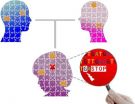Increased social network can have big payoff for nonprofits, study shows
Even small groups can employ social media to ride the new wave of charitable giving
2014-05-28
(Press-News.org) BUFFALO, N.Y. — Charitable fundraising once depended primarily upon a charity's size, efficiency and longstanding reputation. That was before Razoo, Chipin, Facebook and Twitter came to town.
In the first academic study to look at what determines charitable giving on social-media sites, researchers found that those media have created a more level playing field in the nonprofit world, one in which successful use of technology can make up for limited organizational size.
Technology and social media, it turns out, can not only raise the online profile of even small organizations, but increase their support bases and their ability to generate donations online and off.
That is among the findings of "The Social Network Effect: Determinants of Giving Through Social Media," a study by Gregory Saxton, associate professor in the University at Buffalo Department of Communication, and Lili Wang, assistant professor of nonprofit studies in the Arizona State University School of Community Resources and Development.
A photo of Saxton is available here: http://www.buffalo.edu/news/releases/2014/05/037.html.
It was published online in the current issue of Nonprofit and Voluntary Sector Quarterly.
"This paper is innovative in several ways," Saxton says. "It is the first to look at the predictors of donations in a social media setting. It also appears to be the first study of donations on a crowdfunding platform. Furthermore, it examines variables the 'traditional' studies have ignored — the size of the organization's social network and the organization's 'Web capacity.'
"It is in analysis of these variables," says Saxton, "that the study contributes to the theoretical discussion around the determinants of donations."
"The first, and major, unexpected finding," he says, "was that financial ratios, especially the level of a charity's organizational efficiency, were simply unimportant in online giving, although they are known to be prominent determinants of off-line charitable giving.
"Studies that use the economic model of giving have shown that aggregate levels of charitable contributions are positively related to organizational size," says Saxton, "so our second and more minor finding was unexpected as well.
"It was that the size of an organization (measured as total financial assets) did not have a significant positive effect on the number of donations received," he says.
"This led us to surmise that donors on social media and crowdfunding sites do not seem to care how efficient the organization is or how large it is. Instead, they are swayed by what we called the 'social network effect,'" says Saxton, "which is an effect provoked by the size of an organization's network of followers; that is, the number of online 'friends' or fans it has."
The study, which analyzed the fundraising activities of more than 50 organizations using Facebook for that purpose, suggests that if charities understand and cultivate this effect, they could experience a payoff in the number of donations and supporters.
Among the study's findings in that regard:
Online donations are driven by the number of 'friends' that a cause elicits through online sites. Friends often recommend a cause to other friends, which extends the reach the cause or group has.
Donations are also influenced by the Web capacity attached to the charity, which is measured by the number of users reached by the organization's website.
A nonprofit looking for success in social media fundraising should increase the quality and reach of its website, the latter measured by the size of its online constituencies, and encourage its supporters to promote the cause online.
To accomplish this, the organization needs to have the appropriate level of "tech savvy." Having employees who strategically deploy social media strategies can be just as important to their success as having adequate financial resources.
Nonprofits in some fields are more likely to succeed in social media fundraising than others. Especially successful are those that support health-related causes and, in particular, present an immediate need or benefit to the public — treatment for a sick child, a home for a wounded soldier, a campaign to save a life.
Social factors may be pushing donors to give more to popular and socially acceptable causes. This has implications for organizations whose efforts are less well-known than others or do not focus on popular "warm and fuzzy" social issues.
Online donors appear to be more willing to fund specific and new projects, rather than pre-existing programs, especially those that offer tangible deliverables like a clubhouse or a new film.
Attention-getting organizations and projects are more likely to receive funding than those that are more passive in their approach to donors.
Such practices as crowdsourcing and mobile donations, which represent a major change in the way individuals donate to charities, offer new ways for nonprofits to generate greater donations.
Online and traditional fundraising methods complement one another. Large numbers of "fans" generated by a good website and social media outreach can be approached using traditional methods as well.
Saxton conducts research on the organizational implications of new and social media, particularly with regard to nonprofit organizations and financial markets. His studies in these areas typically touch on organizations' communication with their external stakeholders, including such issues as organizational disclosure, organizational accountability and stakeholder relations. He is interested in understanding not only why organizations are more or less successful in these areas, but also the effects of different disclosure, stakeholder relations and accountability practices on organizational success.
INFORMATION:
ELSE PRESS RELEASES FROM THIS DATE:
How long should HCV treatment last? Study suggests answers are complex
2014-05-28
BUFFALO, N.Y. – As new treatments for hepatitis C virus (HCV) are approved, biomedical scientists are exploring their mechanisms and what they reveal about the virus. An online publication this month in Hepatology is the first to report real-time tracking of viral decay in the liver and blood in 15 patients with HCV.
Led by Andrew H. Talal, MD, University at Buffalo professor of medicine in the Division of Gastroenterology, Hepatology and Nutrition and corresponding author, the study is the first to trace in real-time how the drug telaprevir inhibits viral replication ...
Study affirms value of epigenetic test for markers of prostate cancer
2014-05-28
A multicenter team of researchers report that a commercial test designed to rule out the presence of genetic biomarkers of prostate cancer may be accurate enough to exclude the need for repeat prostate biopsies in many — if not most — men.
"Often, one biopsy is not enough to definitively rule out prostate cancer," says study researcher Jonathan Epstein, M.D., director of the Division of Surgical Pathology and a professor of pathology, urology and oncology at the Johns Hopkins University School of Medicine. "Our research finds that by looking for the presence or absence ...
Women's contraceptive use influenced by contraception education and moral attitudes
2014-05-28
COLUMBIA, Mo. – Nearly half of all pregnancies in the United States are unintended, and unplanned pregnancies are associated with poorer health and lower rates of educational and economic achievement for women and their children, according to the Centers for Disease Control and Prevention. However, research shows that the desire to avoid pregnancy does not necessarily increase women's use of contraceptives, although this discrepancy is not well understood. Now, MU researchers have found that levels of prior sex education and moral attitudes toward contraception influence ...
Toxins in the environment might make you older than your years
2014-05-28
Why are some 75-year-olds downright spry while others can barely get around? Part of the explanation, say researchers writing in the Cell Press journal Trends in Molecular Medicine on May 28, is differences from one person to the next in exposure to harmful substances in the environment, chemicals such as benzene, cigarette smoke, and even stress.
While the birth date on your driver's license can tell you your chronological age, that might mean little in terms of the biological age of your body and cells. The researchers say that what we need now is a better understanding ...
Cocktail party neuroscience: Making sense of voices in a crowd
2014-05-28
This news release is available in French. Listening to a conversation in the context of a cocktail party presents a great challenge for the auditory system. Without realizing it, one must extract, from a complex mixture of sound, the sound of a single voice to understand and track it. Researchers at Queen's University, lead by Dr. Ingrid Johnsrude, are studying how our brains meet that challenge, and allow us to distinguish specific voices in crowded, noisy and distracting environments. Her studies have revealed that the brain does not simply rely on the incoming ...
New research shows memory is a dynamic and interactive process
2014-05-28
This news release is available in French. Research presented by Morris Moscovitch, from the Rotman Research Institute at the University of Toronto, shows that memory is more dynamic and changeable than previously thought. Dr. Moscovich's results reveal that important interactions between the hippocampus and the neocortex, two regions of the brain, have different yet complementary roles in remembering places and events. These results highlight that different forms of memories exist in the brain, and that these are encoded in different, but interacting parts of the ...
Uncovering clues to the genetic cause of schizophrenia
2014-05-28
NEW YORK, NY (May 21, 2014) — The overall number and nature of mutations—rather than the presence of any single mutation—influences an individual's risk of developing schizophrenia, as well as its severity, according to a discovery by Columbia University Medical Center researchers published in the latest issue of Neuron. The findings could have important implications for the early detection and treatment of schizophrenia.
Maria Karayiorgou, MD, professor of psychiatry and Joseph Gogos, MD, PhD, professor of physiology and cellular biophysics and of neuroscience, and their ...
A path toward more powerful tabletop accelerators
2014-05-28
Making a tabletop particle accelerator just got easier. A new study shows that certain requirements for the lasers used in an emerging type of small-area particle accelerator can be significantly relaxed. Researchers hope the finding could bring about a new era of accelerators that would need just a few meters to bring particles to great speeds, rather than the many kilometers required of traditional accelerators. The research, from scientists at the U.S. Department of Energy's (DOE) Lawrence Berkeley National Laboratory (Berkeley Lab), is presented as the cover story in ...
PTSD treatment cost-effective when patients given choice
2014-05-28
A cost-analysis of post-traumatic stress disorder treatments shows that letting patients choose their course of treatment – either psychotherapy or medication – is less expensive than assigning a treatment and provides a higher quality of life for patients.
In a recent study, published in the Journal of Clinical Psychiatry, PTSD patients allowed to choose between therapies ended up costing about $1,622 less on average per patient per year compared with patients who were assigned treatment. Among patients not given a choice, treatment with prolonged exposure psychotherapy ...
Technology marketers should take consumer life-cycle into account: New Rotman study
2014-05-28
Toronto – If you want grandpa to start using the bank machine instead of standing in line for the teller, the best way to do it is to tell him to "Act now!" with a limited time offer for a banking card, shows new research.
A new study from the University of Toronto's Rotman School of Management suggests marketers should pay attention to where consumers are in their lifecycles when determining how to get them to adopt new technologies.
Marketers may have incorrectly assumed that older consumers avoid products such as debit or credit cards because they are technophobic ...
LAST 30 PRESS RELEASES:
Tracing the quick synthesis of an industrially important catalyst
New software sheds light on cancer’s hidden genetic networks
UT Health San Antonio awarded $3 million in CPRIT grants to bolster cancer research and prevention efforts in South Texas
Third symposium spotlights global challenge of new contaminants in China’s fight against pollution
From straw to soil harmony: International team reveals how biochar supercharges carbon-smart farming
Myeloma: How AI is redrawing the map of cancer care
Manhattan E. Charurat, Ph.D., MHS invested as the Homer and Martha Gudelsky Distinguished Professor in Medicine at the University of Maryland School of Medicine
Insilico Medicine’s Pharma.AI Q4 Winter Launch Recap: Revolutionizing drug discovery with cutting-edge AI innovations, accelerating the path to pharmaceutical superintelligence
Nanoplastics have diet-dependent impacts on digestive system health
Brain neuron death occurs throughout life and increases with age, a natural human protein drug may halt neuron death in Alzheimer’s disease
SPIE and CLP announce the recipients of the 2025 Advanced Photonics Young Innovator Award
Lessons from the Caldor Fire’s Christmas Valley ‘Miracle’
Ant societies rose by trading individual protection for collective power
Research reveals how ancient viral DNA shapes early embryonic development
A molecular gatekeeper that controls protein synthesis
New ‘cloaking device’ concept to shield sensitive tech from magnetic fields
Researchers show impact of mountain building and climate change on alpine biodiversity
Study models the transition from Neanderthals to modern humans in Europe
University of Phoenix College of Doctoral Studies releases white paper on AI-driven skilling to reduce burnout and restore worker autonomy
AIs fail at the game of visual “telephone”
The levers for a sustainable food system
Potential changes in US homelessness by ending federal support for housing first programs
Vulnerability of large language models to prompt injection when providing medical advice
Researchers develop new system for high-energy-density, long-life, multi-electron transfer bromine-based flow batteries
Ending federal support for housing first programs could increase U.S. homelessness by 5% in one year, new JAMA study finds
New research uncovers molecular ‘safety switch’ shielding cancers from immune attack
Bacteria resisting viral infection can still sink carbon to ocean floor
Younger biological age may increase depression risk in older women during COVID-19
Bharat Innovates 2026 National Basecamp Showcases India’s Most Promising Deep-Tech Ventures
Here’s what determines whether your income level rises or falls
[Press-News.org] Increased social network can have big payoff for nonprofits, study showsEven small groups can employ social media to ride the new wave of charitable giving



